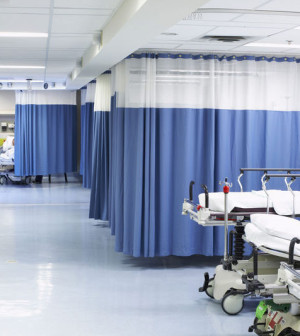- Navigating Your Midlife Crisis: Embracing New Possibilities
- City Raccoons Showing Signs of Domestication
- Mapping the Exposome: Science Broadens Focus to Environmental Disease Triggers
- One Week Less on Social Media Linked to Better Mental Health
- Your Brain Changes in Stages as You Age, Study Finds
- Some Suicide Victims Show No Typical Warning Signs, Study Finds
- ByHeart Formula Faces Lawsuits After Babies Sickened With Botulism
- Switch to Vegan Diet Could Cut Your Greenhouse Gas Emissions in Half
- Regular Bedtime Does Wonders for Blood Pressure
- Dining Alone Could Mean Worse Nutrition for Seniors
Cooling After Cardiac Arrest May Help Preserve Brain Function


Cooling the body might help prevent or lessen brain damage caused by cardiac arrest, a new study suggests.
People who received what is called targeted body temperature management after cardiac arrest — when the heart stops beating — had good outcomes in terms of quality of life and mental function, researchers said. Body temperatures were lowered between 2 and 7 degrees Fahrenheit.
“Among unconscious patients with cardiac arrest treated with targeted body temperature management, more than 90 percent returned home and a significant number were gainfully employed,” said Dr. Venkatesh Aiyagari, professor of neurological surgery and neurology and neurotherapeutics at the University of Texas Southwestern Medical Center in Dallas.
Aiyagari was not involved in the current research, but co-authored an editorial accompanying the study in the April 6 online edition of JAMA Neurology.
Lowering brain temperature is thought to protect brain cells, he said. “The precise mechanisms are still under investigation. Broadly speaking, cooling decreases the need for energy by brain cells that have been injured by decreased blood supply to the brain, decreases inflammation, and inhibits release of toxins that could lead to cell death,” Aiyagari said.
Despite the apparent benefits of lowering patients’ temperatures, it’s rarely done in the United States, Aiyagari added.
A previous study found that, on average, just over 1 percent of cardiac arrest patients were treated with temperature lowering in the United States, Aiyagari said.
“However, the good news is that this percentage increased from 0.34 percent in 2007 to 2.49 percent in 2010,” he said. He added that the proportion of hospitals using temperature lowering was almost 14 percent.
For the current study, a team led by Dr. Niklas Nielsen of Lund University and Helsingborg Hospital in Sweden compared two targeted temperatures on more than 900 adults in cardiac arrest. The patients came from 36 intensive care units in Europe or Australia. They were treated between late 2010 to early 2013.
The researchers randomly assigned patients to have their body temperature lowered. One group was lowered to 91.4 degrees Fahrenheit; the other to 96.8 degrees Fahrenheit, the study authors reported. Normal body temperature is 98.6 degrees Fahrenheit.
Over 36 hours, patients were kept at their targeted temperatures by cooling them or warming them, the researchers said. Patients’ mental function and quality of life were measured six months after the cardiac arrest, according to the study.
At six months after their cardiac arrest, 245 patients in the lowest temperature group were alive, as were 246 in the 96.8 temperature group, the researchers found. Mental function was similar among all the patients.
There was no difference between the groups in increased need for help in activities of daily living. Moreover, most survivors reported that they were independent in their daily activities, and 66.5 percent of patients in the lowest temperature group and 62 percent of the 96.8 temperature group told researchers they thought they had made a complete mental recovery.
Dr. Ralph Sacco is chairman of neurology at University of Miami Miller School of Medicine. “Targeted temperature management with a target of cooling the body and brain has been shown to improve outcomes after cardiac arrest, although debates continue on the actual temperature target,” he said.
“Not all hospitals have protocols for post-cardiac arrest patients, but as the evidence continues to grow, more specialized hospitals with personnel and equipment to treat cardiac arrest patients will be needed,” Sacco said.
More information
For more on cardiac arrest, visit the American Heart Association.
Source: HealthDay
Copyright © 2025 HealthDay. All rights reserved.










